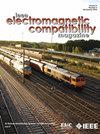Electromagnetic Coupling Estimation Based on Hybrid Equivalent Dipoles and Field-Circuit Models
IF 2
3区 计算机科学
Q3 ENGINEERING, ELECTRICAL & ELECTRONIC
IEEE Transactions on Electromagnetic Compatibility
Pub Date : 2024-08-05
DOI:10.1109/TEMC.2024.3431914
引用次数: 0
Abstract
In most practical electromagnetic interference (EMI) problems, the intricate nature of both EMI source and victim structure often renders direct modeling unfeasible. To address this challenge, this article introduces an innovative EMI estimation method based on hybrid equivalent models. This approach involves the extraction of equivalent dipoles model for EMI source and equivalent circuit model for victim device. To establish the equivalent dipole model for the EMI source, near-field scanning is employed to obtain the phaseless near-field. Subsequently, the dynamic differential evolution method is utilized to derive the equivalent dipole model based on the acquired near-field amplitudes. For the victim's device, a specialized fixture is designed and the de-embedding method is applied to obtain the equivalent基于混合等效偶极子和场电路模型的电磁耦合估计
在大多数实际电磁干扰(EMI)问题中,EMI 源和受害者结构的复杂性往往使直接建模变得不可行。为了应对这一挑战,本文介绍了一种基于混合等效模型的创新 EMI 估算方法。这种方法包括提取 EMI 源的等效偶极子模型和受害器件的等效电路模型。为了建立 EMI 源的等效偶极子模型,采用了近场扫描来获取无相近场。随后,利用动态微分演化法,根据获取的近场振幅推导出等效偶极子模型。对于受害者设备,设计了专门的夹具,并应用去嵌入法获得等效 S 参数模型。将这两个等效模型纳入混合场-电路仿真,就能有效估计 EMI 源和受害者之间的 EMI 耦合。通过数值模拟和物理测量(包括各种 EMI 源和受害器件)的严格验证,证明了所提方法的有效性。
本文章由计算机程序翻译,如有差异,请以英文原文为准。
求助全文
约1分钟内获得全文
求助全文
来源期刊
CiteScore
4.80
自引率
19.00%
发文量
235
审稿时长
2.3 months
期刊介绍:
IEEE Transactions on Electromagnetic Compatibility publishes original and significant contributions related to all disciplines of electromagnetic compatibility (EMC) and relevant methods to predict, assess and prevent electromagnetic interference (EMI) and increase device/product immunity. The scope of the publication includes, but is not limited to Electromagnetic Environments; Interference Control; EMC and EMI Modeling; High Power Electromagnetics; EMC Standards, Methods of EMC Measurements; Computational Electromagnetics and Signal and Power Integrity, as applied or directly related to Electromagnetic Compatibility problems; Transmission Lines; Electrostatic Discharge and Lightning Effects; EMC in Wireless and Optical Technologies; EMC in Printed Circuit Board and System Design.

 求助内容:
求助内容: 应助结果提醒方式:
应助结果提醒方式:


